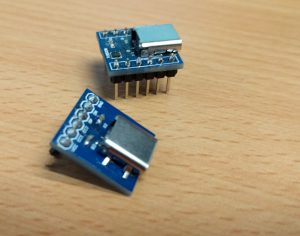The new Type-C USB connector is the latest addition to the USB connector standards. It offers reversible plugs, direction independent cables, USB3.1 speeds, and 3A charging in a connector only a little bigger than the USB 2.0 MicroB connector. In order to add these capabilities the plugs and connectors have additional configuration pins to allow devices to negotiate their state. Supporting the configuration channel may seem like a difficult challenge but it can be achieved fairly simply for the basic use cases.
Type-C as a 2.0 device with a type-C receptacle
In this mode the Type-C device is acting as an UFP (Upstream facing port).
This is the equivalent of devices equipped with either a B, Mini-B or Micro-B socket and majority of hobbyist projects will probably fit into this category.
Luckily this is fairly easy to implement as we can avoid worrying about multiplexing or managing connection states.
The simplest implementation of this is to use two 5.1k pull down resistors on the CC lines.
This allows for detection by other devices when using a USB C-C cable.
The USB 2.0 Data lines can both be connected together at the receptacle as only one pair will be populated in the connector.
The power and ground lines will all want connecting to the appropriate power rails on your board.
The Sideband pins and superspeed pins should be left unconnected in this configuration.
Type-C as a 2.0 device with a type-C plug or captive cable
If you wish to have a device plug directly into a Type-C receptacle this can be done much the same as above with a few small differences.
As the orientation of the plug is fixed at your end only one pull-down configuration resistor (5.1k) will be needed (the one attached to A5). This needs to be the correct cc channel as some devices multiplex the USB2.0 data lines.
In addition only one set of USB 2 data pins should be present in the plug (A6 and A7) so there isn’t a need to connect to both pairs like the previous case.
Using Type-C power on devices
If you want to use Type-C power which provides up to 3A at 5V (note: this is different to the USB Power Delivery capabilities) you will need to monitor the voltages at the CC lines to perform power detection. This can be achieved by either using an ADC or using a IC To manage the CC detection for you. Table 4-25 in the USB Spec covers the voltages that represent the power sources capabilities. note: the capabilities of a host may change while connected so this needs to be monitored throughout the connection.
* less than 0.2v nothing is plugged in/the other CC line is connected.
* between 0.2v and 0.66v only default USB power is available.
* between 0.66v and 1.23v 1.5A USB-C power is available.
* above 1.23v 3A USB-C power is available.
note: there are many out of spec legacy cables available that have the wrong CC pull-up resistor, this leads them to advertising the wrong power capabilities of the charger or host.
Type-C as a 2.0 host or dual role device.
Using Type-C as a DFP (downstream facing port) or a DRP (dual role port) is a bit more complicated than the previous example.
This is because the host needs to detect the connection before connecting VBUS to the device.
While it would be possible to do this yourself there are configuration channel control ICs available to perform this task such as the TUSB320.
These ICs handle the majority of the work for you.
The bits you are left with are turning on VBUS once connection has been established and putting your device into the correct USB mode.
This is often already provided by your controller if it supports USB on-the-go, many configuration ICs have an ID pin that acts like the ID pin on on the go connector for this reason.
Even if you are using the device in host only mode, you will need to enable VBUS only when a connection has been established to prevent two USB devices attempting to provide power at the same time.
For more detail: Using USB Type-C on hobbyist projects


